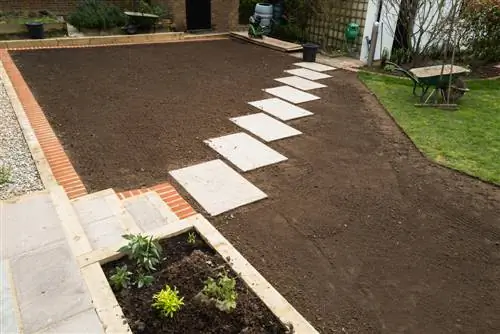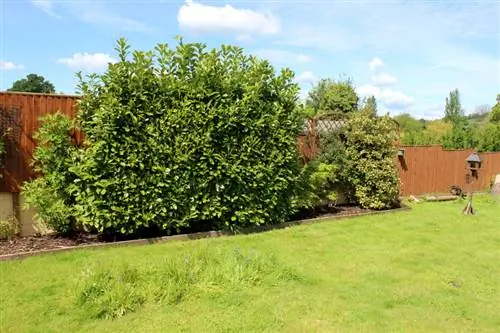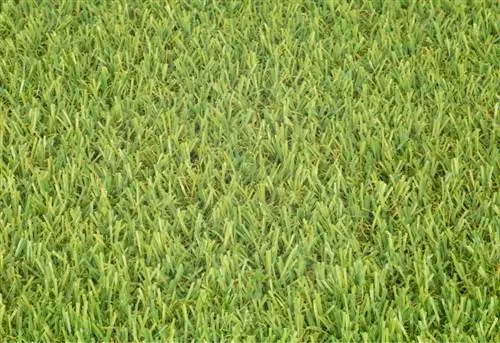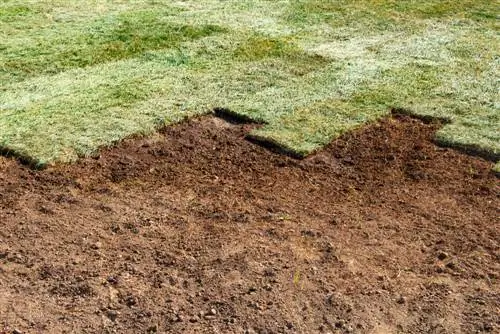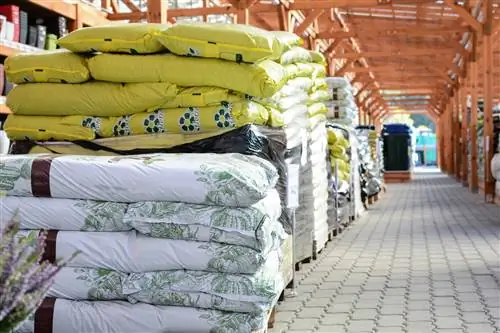- Author admin [email protected].
- Public 2023-12-16 16:46.
- Last modified 2025-01-23 11:22.
For the lawn to grow he althily, regular mowing and balanced fertilization are not enough - instead, a good growth basis must be created with an optimally composed lawn soil. What components the substrate should be made of and what you should pay attention to when buying.
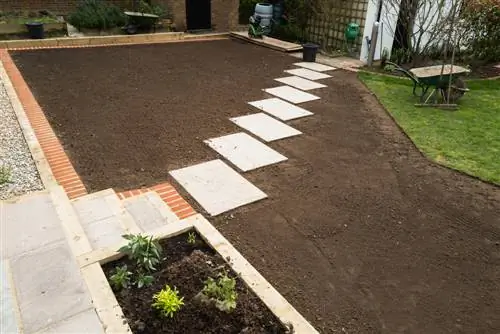
What is lawn soil made of and what is it used for?
Lawn soil is a special substrate mixture that offers optimal growth conditions for lawn grasses and consists of 50% compost, 40% humus and 10% sand. It provides a loose, permeable and nutrient-rich base and is applied directly to the topsoil.
- Lawn soil is a special, industrially produced substrate mixture that is intended to provide various types of lawn with optimal growing conditions.
- You apply the lawn soil directly to the topsoil, creating a loose, permeable and nutrient-rich base.
- Ideally, lawn soil consists of 50 percent compost, 40 percent humus and 10 percent sand. The addition of peat is not necessary.
- Good lawn soil can also be mixed yourself as needed.
What is lawn soil?
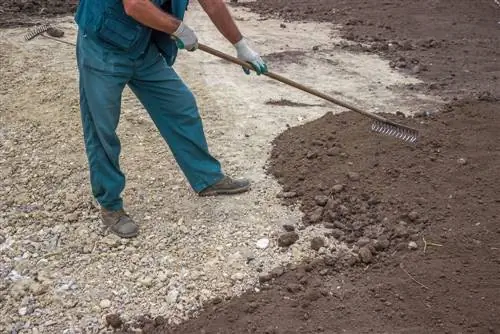
Lawn soil is ideal for growing lawns
Lawn soil is nothing more than a special substrate mixture that is intended to enable optimal growth of lawn grasses. You apply the mixture evenly to the prepared topsoil, level it and then sow the lawn - or lay ready-made lawn if you want to do it quickly. Lawn soil has a very different composition depending on the product and manufacturer. However, this is not only due to the different philosophies of the manufacturers - there are different opinions about the ideal composition of lawn soil - but also depends on the nature of the garden soil.
Sandy soil needs a lawn soil that has a higher proportion of compost and humus as well as a rather low sand content. A clayey subsoil, on the other hand, tolerates a balanced substrate mixture with an equally high proportion of compost and sand - this ensures the necessary permeability of the soil because waterlogging must not form. This means you can find the right lawn soil for every soil composition, especially since the substrate must also be adapted to the type of lawn - after all, play or ornamental lawns have completely different needs.
Features
Lawn soil ideally fulfills several properties that enable he althy grass growth:
- loose composition
- water permeable
- both enable the best possible root growth
- nutrient-rich, humus-rich
- durable
The composition of the lawn soil must not only meet the requirements of the grasses growing on it, but above all it must also be durable. This means that the surface padded with it can withstand any stress and does not become compacted. This point is mainly relevant for commercial and play lawns, but should not be neglected for decorative lawns either.
Optimal composition of lawn soil

In order for the lawn soil to fulfill all of these properties, it needs a special composition. In order to supply the hungry grasses with sufficient nutrients and also to create a good foundation that will last for years, a high compost content of at least 50 percent makes sense. The second most important component of the substrate is humus, which should make up around 30 to 40 percent. Finally, sand provides the necessary permeability and looseness; a proportion of around 10 to 15 percent is ideal.
This composition also ensures exactly the right mix of important nutrients such as nitrogen, phosphate and potassium. In addition, the pH value is preferably between 5.5 and 6, because this is where grasses grow best. However, adding extra fertilizer is not necessary. Fertilization is only applied later, when the lawn has already grown vigorously for a while.
Excursus
Why you should give preference to peat-free lawn soil
Peat was and still is often used in many finished plant substrates and also as pure garden soil. However, the material has now fallen into disrepute for ecological reasons, which is why you should avoid it. Peat is mined in bogs, with the result that valuable habitats for rare plant and animal species are irrevocably lost. In addition, bogs are important CO2 reservoirs, although their storage effect also decreases due to peat mining - with serious consequences for the climate. Peat is not a recommended ingredient for lawn soil anyway, as the same effect is also achieved with compost and humus.
What do you need lawn soil for?
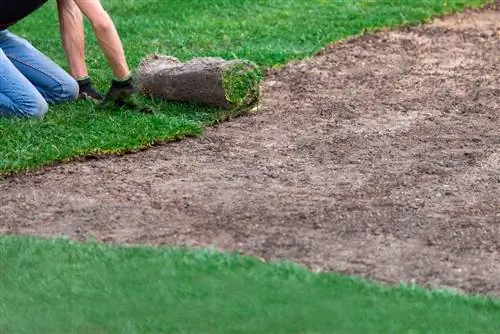
Lawn soil also makes it easier for turf to root
Lawn soil - regardless of whether it is a purchased mixture or your own - forms a good growth basis for every lawn. This means the young grasses stay he althy right from the start and can develop strong roots. Above all, the use of lawn soil levels uneven ground so that the area appears even and without unsightly hills and bumps. Lawn soil is suitable for sowing as well as for rolled turf, lawn tiles or other finished lawns, for new installations as well as for repairing individual spots.
Where can you buy lawn soil?
If you want to buy ready-made lawn soil for the garden, you will find different mixtures from all common manufacturers and brands. You can find corresponding offers at these locations:
- Garden stores or hardware stores with garden departments
- Discounters and supermarkets (not in the permanent range, but occasionally as a special offer)
- various online retailers for garden and plant shipping
- various trading platforms on the Internet (e.g. Amazon, eBay etc.)
- directly on the websites of the preferred brand/manufacturer (e.g. Neudorff, Compo, Floragard etc.)
If you prefer to mix the lawn soil yourself, you can either find the components you need in your own garden or you can also purchase the missing ingredients from the places mentioned. When buying, be sure to pay attention to the composition of the selected substrate, because not every lawn soil is suitable for every soil. In addition, discounter offers in particular are often of low quality or contain a large proportion of peat.
Which lawn soil is the right one?
“The best lawn soil consists of 50 percent compost, 40 percent humus and 10 percent sand.”
Now not all lawn soil is the same. There are different mixtures with different compositions. But which one is the right one? These criteria will help you decide:
- Type and composition of the subsoil: Since one of the most important functions of lawn soil is to compensate for a topsoil composition that is rather unfavorable for grasses, the type of subsoil is one of the most important deciding factors. Sandy soil needs a particularly humus- and nutrient-rich turf soil, while loamy soil needs a mixture with a high sand content. Soil that is too acidic can tolerate calcareous lawn soil, while alkaline soil can tolerate a mixture with rock powder rich in silicon.
- Lawn type: Basically, a distinction is made between play and sports turf (utility turf), ornamental turf and shade turf. All of these species have different needs for their substrate, which is why you should select the lawn soil according to these specific needs. Shade lawns tolerate a somewhat lean substrate, which should also be particularly permeable and, if necessary, balance out an acidic pH value. On the other hand, turf for use must be very hard-wearing and must not compact under load - here too, permeability and looseness are the top priority.
- Application form: The desired application of the lawn soil is also relevant for the choice of variety. Depending on whether you want to create a new lawn or repair it, or whether you want to regenerate or repair a stressed and damaged lawn, different substrate mixtures make sense. Which one should be your first choice also depends on the surface.
- Special compositions: You can buy lawn soil ready-made with grass seeds, you just have to spread them over the lawn and no longer need to sow them. Extra-fertilized lawn soil, on the other hand, is particularly suitable for poor soils or rather demanding lawn mixtures.
How much does lawn soil cost?
How deep you have to dig into your wallet for lawn soil depends entirely on the brand you choose and the composition of the product. There is
- pure lawn soil
- Lawn soil with fertilizer
- Lawn soil with grass seeds already mixed in
- Lawn soil with sand / quartz sand
Depending on the manufacturer and ingredients, the prices range quite widely between around 20 cents and around 1.30 EUR per liter. Since you usually need a lot of lawn soil, depending on the area you plan to use, there are packs available in stores that contain 20, 40, 60, 70 or even 100 liters.
Can you mix lawn soil yourself?
If you want to mix lawn soil yourself, you only need three basic substances:
- Compost
- Humus
- Sand
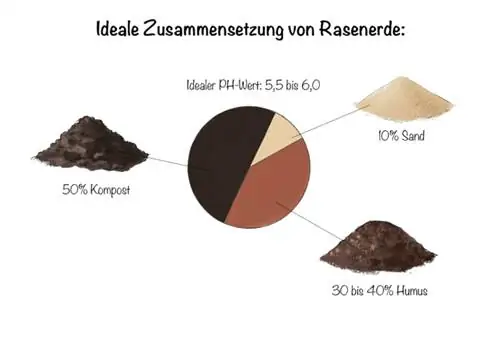
Nutrient-rich compost makes up the largest and most important portion of self-composed lawn soil, at around 50 percent. To do this, use mature garden compost, which consists of mixed garden and kitchen waste and has a neutral pH value.
If you want to balance a strongly alkaline substrate, mix in a portion of acidic leaf humus - ultimately the desired pH value should be achieved. Alternatively, you can also use bark humus or rhododendron soil. Purchased humus soil is very suitable for the humus content - or you can remove the valuable soil from molehills and sift it through. Quartz sand is suitable as sand, but also play sand.
Depending on the substrate and nutrient requirements, you can also mix in primary rock dust or silicon-rich stone powder, horn meal or horn shavings or a long-term mineral fertilizer. The stone powder provides an extra portion of minerals and helps to improve the soil structure, while the fertilizers supply the growing lawn with nitrogen. This nutrient is particularly important for the growth of grasses.
Excursus
Soil analysis is done before mixing
But be careful: Before adding these substances, have a soil analysis carried out first so as not to accidentally risk over-fertilization or deficiency. You take several samples of the topsoil (not the lawn soil you mixed yourself!) and send them to a specialized laboratory for soil testing. You will then receive a detailed list of the nutrients it contains and tips for optimal fertilization.
Use lawn soil correctly
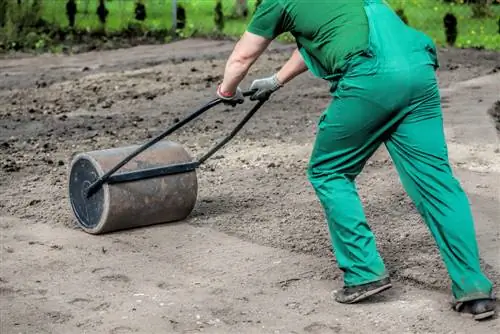
The lawn soil is rolled before and after sowing or laying the lawn
Whether you bought it or mixed it yourself, you can use the finished lawn soil as follows:
- Preparation of the subsurface
- Digging and loosening the topsoil
- Removing weeds and other organic materials and stones
- Level the surface and rake it smooth
- Crumble larger chunks of earth finely
- Apply lawn soil evenly to the surface
- Level and roll the surface
- No unevenness may remain.
- Sowing lawn seeds or laying finished lawn
- Roll the surface again
- Water the area vigorously
Rolling the seeds is important so that the seeds are pressed down and not blown away with the next breath of wind. On uneven lawns, the seeds also germinate very unevenly, which later results in an inconsistent overall picture. Newly laid lawns may not be walked on at first, but you should definitely water them regularly and vigorously. This supports germination and later root formation. The surfaces must not dry out under any circumstances!
Excursus
Sowing the lawn or laying turf?
Instead of sowing the lawn, you can simply lay turf on the prepared area. This has the advantage that you don't have to wait long for the grass to germinate and grow, but you have a finished lawn straight away. However, rolled turf is not a cheap affair and is therefore particularly suitable for smaller areas.
Frequently asked questions
What do I have to do before spreading lawn soil and lawn seeds?
Of course, it is not enough to simply spread lawn soil on the intended lawn area and then sow it. A little more preparation is necessary because the surface also needs to be loosened well, cleared of weeds and stones and then straightened. Only then do you apply the lawn soil.
When do you actually sow lawn?
Spring is the ideal time to sow lawns. If the weather is suitable - temperatures above 12 degrees Celsius - you can start sowing between March and April. However, the ground should be frost-free, and a few warm days are an advantage - the earth should already be slightly warmed up. If there is a threat of late frosts orDue to winter weather, sowing is still unlikely. In this case, just wait a little longer until the temperatures are more stable and the sun has more strength.
Do I have to fertilize the lawn before sowing?
If you apply lawn soil with a high proportion of compost and humus before sowing, additional fertilization is not necessary. If purchased ready-made, the substrate is already pre-fertilized and contains all the necessary nutrients in sufficient quantities and in an optimal composition. Even self-mixed lawn soil is nutrient-rich with the recipes we provide and no longer needs to be fertilized. However, you must ensure that you always keep freshly sown lawn slightly moist - this way it will germinate better.
How thick does the layer of lawn soil have to be?
Since the types of grass mixed for common lawns all have shallow roots, the layer of lawn soil can be spread very thinly. A thickness of around one to one and a half centimeters is sufficient. However, make sure that you distribute the substrate evenly and level any unevenness before sowing.
Tip
Lawn should be watered less frequently, but thoroughly and thoroughly. Avoid giving less water at short intervals. Here the water doesn't reach deep enough into the earth, so the roots grow very shallow instead of deeper. In the long term, this makes the lawn more susceptible to drought damage, as the shallow roots cannot absorb sufficient moisture over time.

